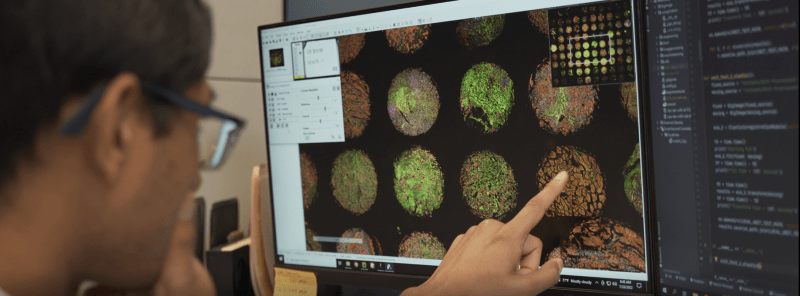Overview
Biological images provide a wealth of information for various applications, enabling us to gain valuable insights into disease, understand biological processes, and drive advancements in research and development. For example, histological tissue sections play a critical role in disease diagnosis, understanding, and assessing therapies in drug discovery and development. Within these sections, crucial prognostic data is embedded, offering valuable insights into disease aggressiveness and patient outcomes. At Visikol, we leverage the power of machine learning to offer cutting-edge segmentation services tailored to your specific needs, regardless of the type of biological image you’re working with.
With significant advancements in computer software and hardware, machine learning has become an essential tool in a wide range of disciplines. Within the field of bio-imaging, major breakthroughs in computer vision and image processing techniques have revolutionized our ability to analyze and extract information from biological images.
Our Machine Learning Segmentation Services utilize classical or deep learning techniques based on supervised machine learning. Supervised machine learning involves training our algorithms on annotated datasets, where human experts carefully annotate the objects of interest to guide the learning process. This approach allows our algorithms to recognize and segment specific structures, patterns, or biomarkers within your biological images accurately.
Key Features of our Machine Learning Segmentation Services:
- Comprehensive Approach: Our services cater to a diverse range of biological images, including histological sections and various other types of imaging modalities. Whether you’re working with immunofluorescence, immunohistochemistry, or other biological images, our machine learning algorithms can effectively segment the objects you’re interested in.
- Supervised Machine Learning: In supervised machine learning, we leverage well-annotated training datasets to teach our algorithms to recognize and segment objects within the images. Our team of experts works closely with you to curate high-quality training datasets, ensuring that the annotations accurately represent the objects you wish to segment. This supervised approach enhances the accuracy and precision of the segmentation results.
- Customized Solutions: Our services are tailored to meet the unique requirements of your project. We work closely with you to understand your objectives and optimize our segmentation approach accordingly. Whether you need cell segmentation, tissue segmentation, or delineation of specific structures of interest, our solutions are designed to deliver accurate and reliable results.
- Precision and Efficiency: By leveraging machine learning, we automate the segmentation process, ensuring precise and efficient analysis. This eliminates the need for manual segmentation, reducing human error and saving valuable time and resources.
- Expert Analysis: Our team of skilled image analysts possess deep expertise in image segmentation. They meticulously evaluate and validate the segmentation results to ensure their accuracy and reliability.
- Enhanced Insights: Accurate segmentation of images provides a foundation for subsequent quantitative analysis, enabling comprehensive assessments of cell populations, spatial relationships, and biomarker expressions. These insights can significantly advance your research and improve decision-making processes.
Partner with Visikol for machine learning-based segmentation of your biological images. Our cutting-edge technology and expertise empower you to unlock the hidden potential within your data, facilitating breakthrough discoveries and enhancing scientific understanding.
Analysis Compatibilities and Deliverables
| File Formats | TIFF, PNG, JPEG |
| Image Submission | Hard Drive Visikol Cloud Sharing Client Selected File Sharing Service |
| Data Delivery | Report Segmentation Masks |
General Procedure
- Training data checked to make sure the quality is good for training.
- The model is trained with the data provided and precision, recall, and accuracy are used to determine model performance.
- The trained model is validated against a separate testing set to ensure robustness.
- A report is sent to the client about the model development.
- Next steps to be determined with client for use of model or implementation.

